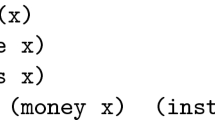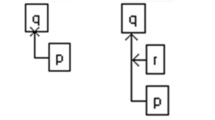Abstract
Computational approaches to the law have frequently been characterized as being formalistic implementations of the syllogistic model of legal cognition: using insufficient or contradictory data, making analogies, learning through examples and experiences, applying vague and imprecise standards. We argue that, on the contrary, studies on neural networks and fuzzy reasoning show how AI & law research can go beyond syllogism, and, in doing that, can provide substantial contributions to the law.
Similar content being viewed by others
References
Grünhut, M. 1926. Begriffsbildung und Rechtsanwendung im Strafrecht. Tübingen: Mohr.
Hart, H.L.A. 1961. The Concept of Law. Oxford: Oxford University Press.
Hayek, F.A. 1973. Law Legislation and Liberty. Volume I. Rules and Order. London: Routledge and Kegan Paul.
Hayek, F.A. 1976. Law Legislation and Liberty. Volume II. The Mirage of Social Justice. London: Routledge and Kegan Paul.
Hayek, F.A. 1977. New Studies in Philosophy, Politics, Economics and the History of Ideas. London: Routledge and Kegan Paul.
Hayek, F.A. 1979. Law Legislation and Liberty. Volume III. The Political Order of a Free People. London: Routledge and Kegan Paul.
Heck, Ph. 1914. Gesetzesauslegung und Interessenjurisprudenz. Tübingen: Mohr.
Kosko, B. 1993. Fuzzy Thinking, the New Science of Fuzzy Logic. New York: Hyperion.
Perelman, Ch. and Olbrechts-Tyteca, L. 1969. The New Rhetoric. A Treatise on Argumentation. Notre Dame (Indiana): University of Notre Dame Press.
Prakken, H. 1997. Logical Tools for Modelling Legal Argument. A Study of Defeasible Reasoning in Law. Dordrecht: Kluwer.
Philipps, L. 1991. Tû-Tû 2. Von Rechtsbegriffen und neuronalen Netzen. In L. Philipps and R. Wittmann (eds), Rechtsentstehung und Rechtskultur. Festschrift für Heinrich Scholler, Heidelberg: Decker & Müller, pp. 179–189.
Author information
Authors and Affiliations
Rights and permissions
About this article
Cite this article
Philipps, L., Sartor, G. Introduction: from legal theories to neural networks and fuzzy reasoning. Artificial Intelligence and Law 7, 115–128 (1999). https://doi.org/10.1023/A:1008371600675
Issue Date:
DOI: https://doi.org/10.1023/A:1008371600675




